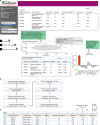ProTargetMiner as a proteome signature library of anticancer molecules for functional discovery
- PMID: 31844049
- PMCID: PMC6915695
- DOI: 10.1038/s41467-019-13582-8
ProTargetMiner as a proteome signature library of anticancer molecules for functional discovery
Abstract
Deconvolution of targets and action mechanisms of anticancer compounds is fundamental in drug development. Here, we report on ProTargetMiner as a publicly available expandable proteome signature library of anticancer molecules in cancer cell lines. Based on 287 A549 adenocarcinoma proteomes affected by 56 compounds, the main dataset contains 7,328 proteins and 1,307,859 refined protein-drug pairs. These proteomic signatures cluster by compound targets and action mechanisms. The targets and mechanistic proteins are deconvoluted by partial least square modeling, provided through the website http://protargetminer.genexplain.com. For 9 molecules representing the most diverse mechanisms and the common cancer cell lines MCF-7, RKO and A549, deep proteome datasets are obtained. Combining data from the three cell lines highlights common drug targets and cell-specific differences. The database can be easily extended and merged with new compound signatures. ProTargetMiner serves as a chemical proteomics resource for the cancer research community, and can become a valuable tool in drug discovery.
Conflict of interest statement
B.Z. is currently an employee of AstraZeneca. Alexey Chernobrovkin is currently an employee of Pelago Bioscience AB. The other authors declare no potential conflicts of interest.
Figures







References
Publication types
MeSH terms
Substances
LinkOut - more resources
Full Text Sources
Molecular Biology Databases

